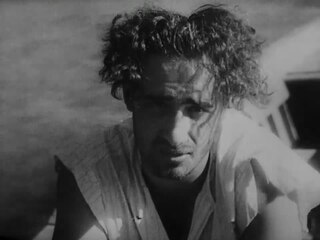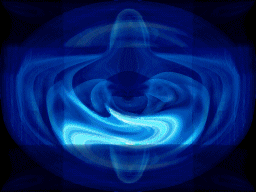
Drawn-on-film animation, also known as direct animation or animation without camera, is an animation technique where footage is produced by creating the images directly on film stock, as opposed to any other form of animation where the images or objects are photographed frame by frame with an animation camera.
Oskar Wilhelm Fischinger was a German-American abstract animator, filmmaker, and painter, notable for creating abstract musical animation many decades before the appearance of computer graphics and music videos. He created special effects for Fritz Lang's 1929 Woman in the Moon, one of the first sci-fi rocket films, and influenced Disney's Fantasia. He made over 50 short films and painted around 800 canvases, many of which are in museums, galleries, and collections worldwide. Among his film works is Motion Painting No. 1 (1947), which is now listed on the National Film Registry of the U.S. Library of Congress.

Charlotte "Lotte" Reiniger was a German film director and the foremost pioneer of silhouette animation. Her best known films are The Adventures of Prince Achmed, from 1926, the oldest surviving feature-length animated film, and Papageno (1935). Reiniger is also noted for having devised, from 1923 to 1926, the first form of a multiplane camera. Reiniger worked on more than 40 films throughout her career.

Experimental film or avant-garde cinema is a mode of filmmaking that rigorously re-evaluates cinematic conventions and explores non-narrative forms or alternatives to traditional narratives or methods of working. Many experimental films, particularly early ones, relate to arts in other disciplines: painting, dance, literature and poetry, or arise from research and development of new technical resources.

Viking Eggeling was a Swedish avant-garde artist and filmmaker connected to dadaism, Constructivism, and abstract art and was one of the pioneers in absolute film and visual music. His 1924 film Diagonal-Symphonie is one of the seminal abstract films in the history of experimental cinema.

Walter Ruttmann was a German cinematographer and film director, an important German abstract experimental film maker, along with Hans Richter, Viking Eggeling and Oskar Fischinger. He is best known for directing the semi-documentary 'city symphony' silent film, with orchestral score by Edmund Meisel, in 1927, Berlin: Symphony of a Metropolis. His audio montage Wochenende (Weekend) (1930) is considered a major contribution in the development of audio plays.
Visual music, sometimes called color music, refers to the creation of a visual analogue to musical form by adapting musical structures for visual composition, which can also include silent films or silent Lumia work. It also refers to methods or devices which can translate sounds or music into a related visual presentation. An expanded definition may include the translation of music to painting; this was the original definition of the term, as coined by Roger Fry in 1912 to describe the work of Wassily Kandinsky. There are a variety of definitions of visual music, particularly as the field continues to expand. In some recent writing, usually in the fine art world, visual music is often confused with or defined as synaesthesia, though historically this has never been a definition of visual music. Visual music has also been defined as a form of intermedia.
William Moritz, film historian, specialized in visual music and experimental animation. His principal published works concerned abstract filmmaker and painter Oskar Fischinger. He also wrote extensively on other visual music artists who worked with motion pictures, including James and John Whitney and Jordan Belson; Moritz also published on German cinema, Visual Music, color organs, experimental animation, avant-garde film and the California School of Color Music.

Motion graphics are pieces of animation or digital footage which create the illusion of motion or rotation, and are usually combined with audio for use in multimedia projects. Motion graphics are usually displayed via electronic media technology, but may also be displayed via manual powered technology. The term distinguishes static graphics from those with a transforming appearance over time, without over-specifying the form. While any form of experimental or abstract animation can be called motion graphics, the term typically more explicitly refers to the commercial application of animation and effects to video, film, TV, and interactive applications.
Mary Ellen Bute was a pioneer American film animator, producer, and director. She was one of the first female experimental filmmakers, and was the creator of some of the first electronically generated film images. Her specialty was visual music; while working in New York City between 1934 and 1958, Bute made fourteen short abstract musical films. Many of these were seen in regular movie theaters, such as Radio City Music Hall, usually preceding a prestigious film. Several of her abstract films were part of her Seeing Sound series.

Léopold Frédéric Léopoldowitsch Survage was a Russian-French painter of Finnish origin. Trained in Moscow, he identified with the Russian avant-garde before moving to Paris, where he shared a studio with Amedeo Modigliani and experimented with abstract movies. He also gained commissions for Serge Diaghilev's Ballets Russes.
Begone Dull Care is a 1949 visual music animated film directed by Norman McLaren and Evelyn Lambart for the National Film Board of Canada (NFB).

Robert Carlton Breer was an American experimental filmmaker, painter, and sculptor.

The Idea is a 1932 French animated film by Austro-Hungarian filmmaker Berthold Bartosch (1893–1968), based on the 1920 wordless novel of the same name by Flemish artist Frans Masereel (1889–1972). The protagonist is a naked woman who represents a thinker's idea; as she goes out into the world, the frightened authorities unsuccessfully try to cover up her nudity. A man who stands up for her is executed, and violent suppression by big business greets a workers' revolution she inspires.
Non-narrative film is an aesthetic of cinematic film that does not narrate, or relate "an event, whether real or imaginary". It is usually a form of art film or experimental film, not made for mass entertainment.
Maureen Selwood is an Irish-born American filmmaker and visual artist whose works employ simple line drawings, marriages between animation and live footage, digital projections and installations. She is a pioneer in the field of independent and experimental animation. She has received numerous awards, including a Guggenheim Fellowship (1992), and is the first animation artist to be awarded the Rome Prize (2002) in Visual Arts from the American Academy in Rome.

The Tesla World Light is an 8-minute 2017 black and white avant-garde film by Montreal director Matthew Rankin imagining the latter days of inventor Nikola Tesla in 1905 in New York City. Rankin has stated that he was interested in exploring Tesla's optimistic utopian vision. The film is a fanciful amalgamation of elements from Tesla's life including his 1905 pleadings for J.P. Morgan to continue funding his World Wireless System and his love for a pigeon. Rankin has stated that "everything in the film is drawn from something [Tesla] wrote or said." The film uses excerpts of Tesla's actual letters to Morgan, which the filmmaker found in the Library of Congress; even a reference to Tesla falling in love with an "electric pigeon" was based on an interview with Tesla, according to Rankin. The film is produced by Julie Roy for the National Film Board of Canada.
Opus IV is a 1925 German absolute film directed by Walter Ruttmann. The film is approximately 3m 55s in length. It uses abstract animation.

A Colour Box is a 1935 British experimental animated film by Len Lye. Commissioned to promote the General Post Office, it was Lye's first direct animation to receive a public release.
Arthouse animation is a combination of art film and animated film.













